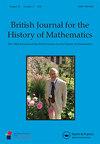Introducing differential calculus in Spain: The fluxion of the product and the quadrature of curves by Tomàs Cerdà
IF 0.3
Q3 MATHEMATICS
British Journal for the History of Mathematics
Pub Date : 2020-12-06
DOI:10.1080/26375451.2020.1829864
引用次数: 0
Abstract
Differential calculus was introduced into eighteenth-century Spain through the teaching of several authors in different scientific institutions. One of the more noteworthy of these Spanish authors was the Jesuit Tomàs Cerdà (1715–1791), who taught mathematics at the College of Cordelles in Barcelona and at the Imperial College in Madrid. This mathematician introduced differential calculus through the manuscript entitled ‘Tratado de Fluxiones’ (1757–1759), which had as a main source The Doctrine and Application of Fluxions (1750) by Thomas Simpson (1710–1761). Our aim in this paper is to analyse Cerdà’s special contribution to the introduction into Spain of the Newtonian theory of fluxions based on Simpson’s definition of a fluxion. Specifically, the paper shows that Cerdà deduced the fluxion of the product of two variables and the area under a curve by previously establishing the fluxion of a curvilinear surface, a particular and different approach to that employed by other contemporaneous mathematicians in Spain.在西班牙介绍微分学:Tomàs Cerdà的积的流动和曲线的求积
微分学是通过不同科学机构的几位作者的教学引入18世纪的西班牙的。这些西班牙作家中比较值得注意的一位是耶稣会士Tomàs cerd(1715-1791),他在巴塞罗那的Cordelles学院和马德里的帝国学院教授数学。这位数学家通过题为“Tratado de Fluxiones”(1757-1759)的手稿介绍了微分学,该手稿的主要来源是托马斯·辛普森(1710-1761)的《Fluxions的原理和应用》(1750)。本文的目的是分析塞尔多塞在将牛顿的流通量理论引入西班牙方面的特殊贡献,该理论基于辛普森对流通量的定义。具体地说,这篇论文表明,cerd通过先前建立曲线表面的通量,推导出了两个变量乘积的通量和曲线下面积的通量,这是一种特殊的、不同于同时代西班牙其他数学家所采用的方法。
本文章由计算机程序翻译,如有差异,请以英文原文为准。
求助全文
约1分钟内获得全文
求助全文
来源期刊

British Journal for the History of Mathematics
Arts and Humanities-History and Philosophy of Science
CiteScore
0.50
自引率
0.00%
发文量
22
 求助内容:
求助内容: 应助结果提醒方式:
应助结果提醒方式:


